Looking to shed some extra pounds and get in shape? Dumbbell strength training exercises for beginners are a great way to start.
These exercises use simple weights that you can find at any gym or even use at home.
They’re super versatile and help you work out different parts of your body, making them perfect for weight loss.
Just a few sessions each week can make a big difference in how you look and feel.
So, grab those dumbbells and let’s get started on your fitness journey.
How Dumbbell Strength Training exercises Helps with Weight Loss
When doing any type of workout, you burn calories which are only during the workout but after it the workout it stops.
But when you incorporate dumbbell strength training exercises into your workout routine, you’ll burn calories after the workout also, which eventually helps you to burn more and more calories.
When you engage in dumbbell strength training exercises, you’re not only targeting specific muscle groups but also stimulating muscle growth. And it is the main benefit of building more and more muscle.
It is because muscle is more metabolically active than fat.
So, it will help you burn more and more calories by increasing your metabolism even while you’re watching TV or resting on a couch.
But that’s not all. There are other factors at play too. Things like the intensity of your workout, the duration, and even your body composition can influence how many calories you torch during your dumbbell strength training sessions.
And let’s not forget the afterburn effect—aka excess post-exercise oxygen consumption (EPOC). This fancy term basically means your body continues to burn calories even after you’ve finished your workout, thanks to the increased oxygen consumption during intense exercise.
So, if you’re ready to break those fats and build up a toned physique, let’s dive into some killer dumbbell strength training exercises.
Ready to get started? Let’s begin with the exercises.
Here is a tip: This is a vast list of Dumbbell strength training Exercises, but this list is only for hit and trail.
Let me explain, each person is different and so talking on that note you have to pick only those exercises which give you most of the benefits.Let’s take an example, when doing biceps curls, I feel mind muscle connection in the dumbbell curls and my workout buddy feels in the barbell curls.
Out of this list find which fits for you. And this finding takes time and patience. So, keep going and make your own workout routine.
Dumbbell Strength Training Exercises for Beginners
CHEST
Dumbbell Incline Press
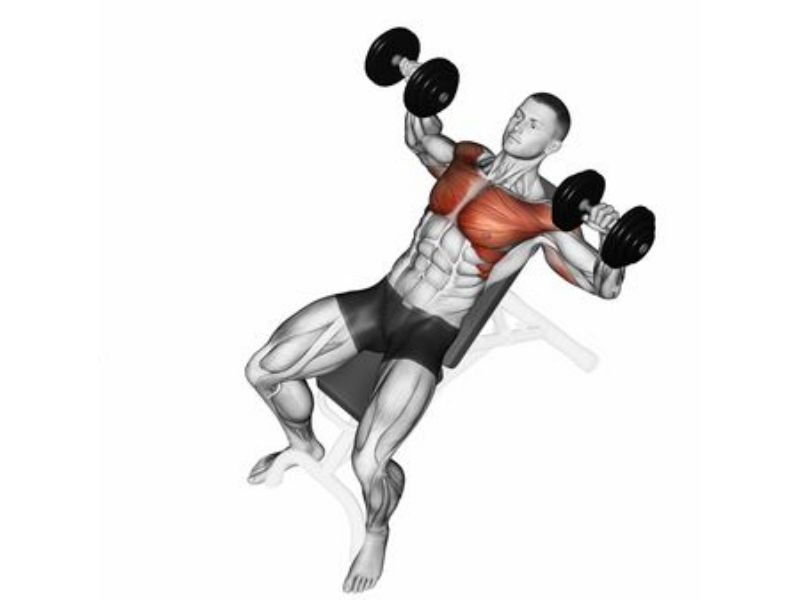
- Grab two dumbbells that feel comfortably challenging. Lie on an adjustable bench set to an incline (around 30-45 degrees).
- Hold the dumbbells directly above your shoulders with your palms facing forward. Feel your chest stretch slightly as you grip the weights.
- Slowly lower the dumbbells down in a controlled arc on either side of your chest, feeling a stretch in your upper pecs. Imagine you’re trying to hug the dumbbells together slightly below your chest.
- Keep your core engaged throughout the movement. Feel your chest muscles squeeze at the bottom of the movement.
- Press the dumbbells back up to the starting position in a controlled motion, keeping your elbows slightly bent and not locked out at the top.
Pro-Tip: Feel your lower back pressed into the bench for support. It will not influence your lower back.
Incline Dumbbell Flyes
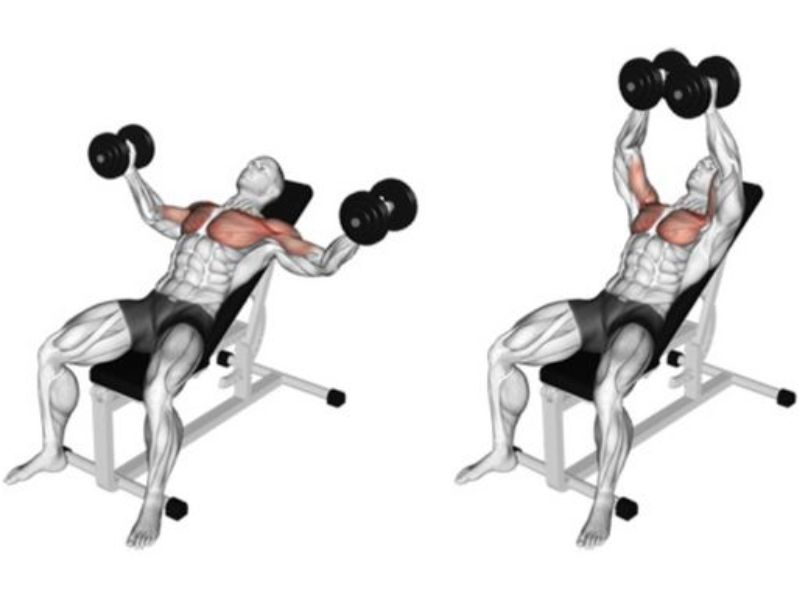
- Same setup as the Incline Press: dumbbells in hand, lying on an incline bench.
- Start with the dumbbells held up above your chest, palms facing each other.
- Keeping a slight bend in your elbows, slowly lower the dumbbells down in a wide arc until you feel a stretch in your chest. Imagine you’re opening a giant book.
- Don’t let the dumbbells touch the bottom and avoid arching your back.
- Squeeze your chest muscles to bring the dumbbells back up to the starting position, feeling your pecs contract at the top.
Pro-tip: When bringing the dumbbells back, try to touch your pinky finger or try to touch the ends of each dumbbell, as beginner will get help in squeezing.
Dumbbell Bench Press
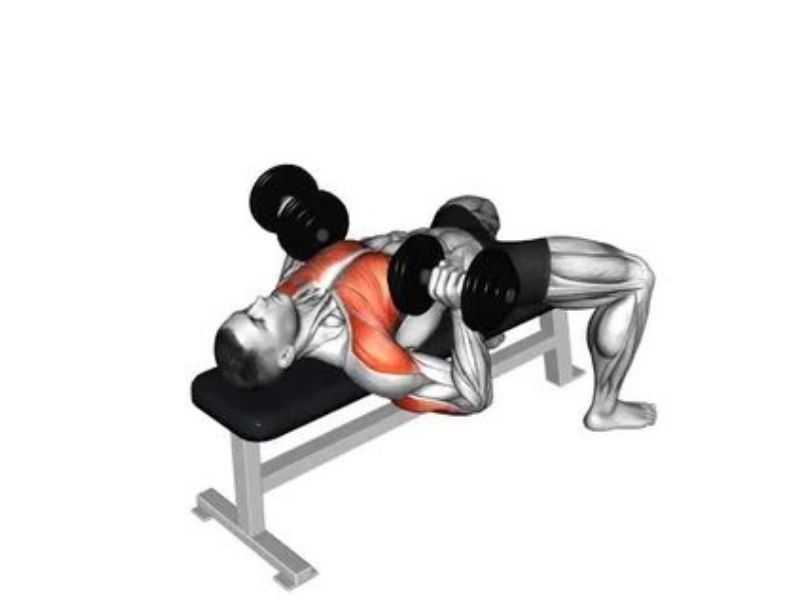
- Grab two dumbbells that feel comfortably challenging. Lie flat on a stable bench.
- Hold the dumbbells directly above your shoulders with your palms facing forward. Feel your chest stretch slightly.
- Lower the dumbbells down in a controlled arc on either side of your chest, elbows tucked in close to your body.
- Keep your core engaged throughout the movement. Feel your chest muscles squeeze at the bottom of the movement.
- Once your elbows reach a 90-degree angle (or slightly lower), press the dumbbells back up to the starting position, squeezing your chest muscles as you go.
Pro-tip: when lowering the dumbbell, Imagine you're lowering the dumbbells towards your armpit area.
Flat Dumbbell Flyes
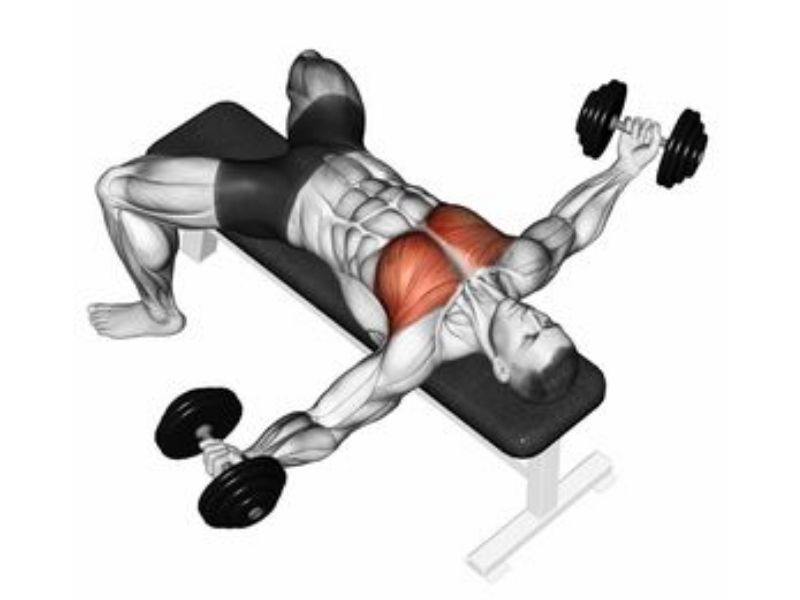
- Lie flat on a bench with dumbbells in hand, palms facing each other.
- Start with the dumbbells held straight up above your chest.
- Keeping a slight bend in your elbows, slowly lower the dumbbells down in a wide arc until you feel a stretch in your chest.
- Don’t let the dumbbells touch the bottom and avoid arching your back.
- Squeeze your chest muscles to bring the dumbbells back up to the starting position, feeling your pecs contract at the top.
Pro-tip: Same as the incline fly, try to touch the ends of each dumbbell to feel more squeezing.
Decline Dumbbell Press
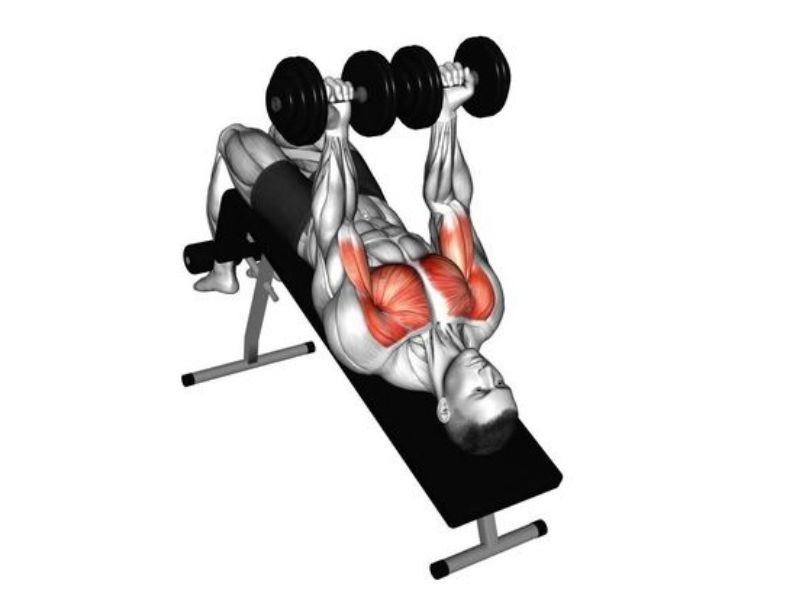
- Set the bench to a decline (around 15-30 degrees).
- Lie down with the dumbbells held directly above your shoulders, palms facing forward. Feel your lower chest muscles stretch slightly here.
- Lower the dumbbells down in a controlled arc on either side of your chest, bringing them lower than your chest (but not touching).
- Press the dumbbells back up to the starting position, feeling your lower chest muscles contract and powering the movement.
Pro-Tip: Imagine you're trying to draw a big "V" shape with your forearms as you lower. Feel your lower chest muscles working.
Decline Dumbbell Flyes
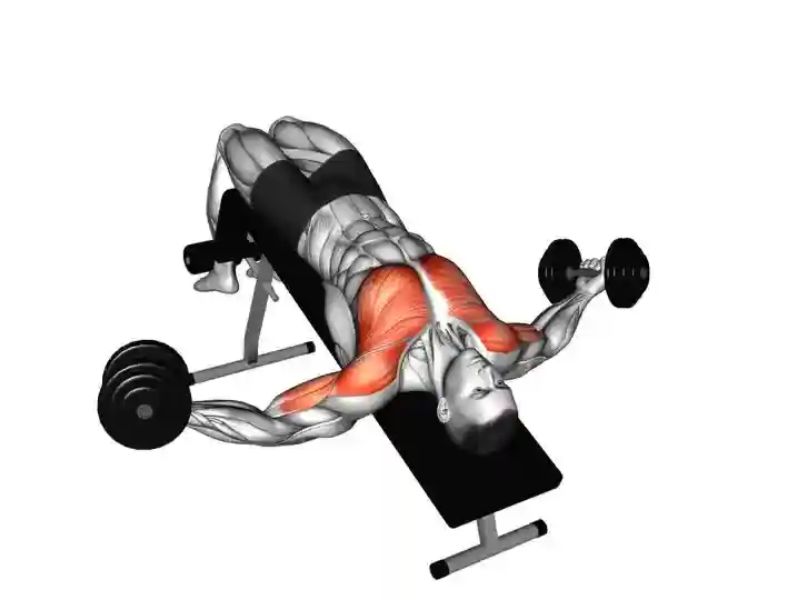
- The same setup as the decline press, but with a focus on the flyes motion.
- Start with the dumbbells together at the top, palms facing forward. Feel your lower chest muscles stretch slightly here.
- Slowly lower the dumbbells out to the sides in a wide arc, keeping a slight bend in your elbows.
- Don’t let the dumbbells touch at the bottom of the movement.
- Squeeze your lower chest muscles to bring the dumbbells back together at the top, keeping your arms straight but not locked at the elbows.
Pro-Tip: Imagine you're giving someone a big hug but targeting your lower chest. Feel the stretch in your lower chest muscles as you lower.
BACK
Dumbbell Bent-Over Rows

- Grab dumbbells that challenge you, but allow you to maintain good form throughout (think controlled movement).
- Stand with your feet shoulder-width apart and hinge at your hips, pushing your glutes back as if you’re about to sit in a chair. Keep your back straight but not hyperextended (think proud chest).
- Hold the dumbbells with palms facing each other, arms straight down towards the floor. Feel a slight stretch in your lower back and hamstrings here.
- Now, row the dumbbells up towards your sides, keeping your elbows close to your body and squeezing your shoulder blades together at the top. Imagine you’re trying to pinch your shoulder blades together in your back pocket. Feel your back muscles doing the work, not your biceps.
- Lower the dumbbells back down to the starting position with control, maintaining the hinge at your hips and a straight back.
Pro-tip: Imagine your core is engaged and helping to hold your spine in a neutral position.
Romanian Deadlift with dumbbell
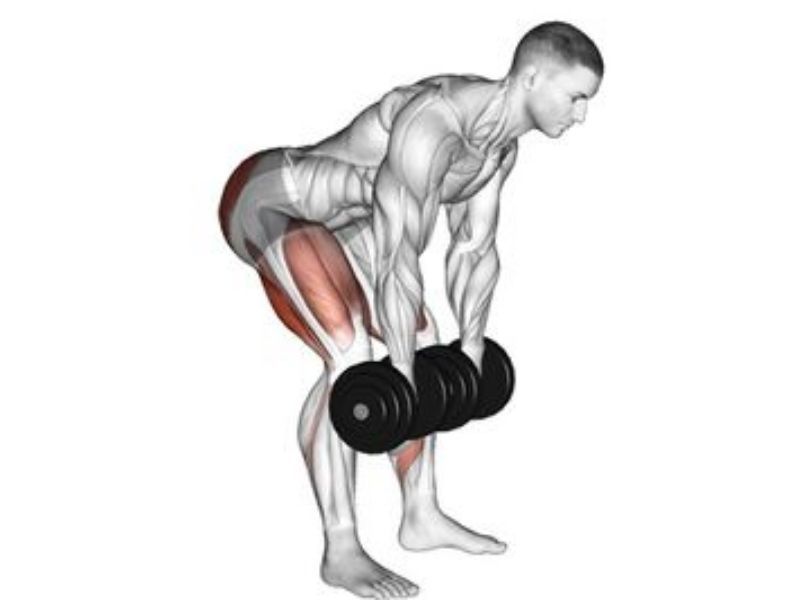
- Stand with your feet shoulder-width apart and knees slightly bent. Hold a dumbbell in each hand, arms hanging straight down in front of your thighs.
- Keeping your back straight and core engaged, hinge at your hips and slowly push your glutes back as you lower the dumbbells down towards the floor.
- Lower the dumbbells until you feel a slight stretch in your hamstrings (back of your thighs) and glutes. Don’t round your back!
- Squeeze your glutes and hamstrings to return to the starting position, keeping the dumbbells close to your body throughout the movement.
Pro-tip: Imagine pushing your heels back into the ground.
Dumbbell Pullovers
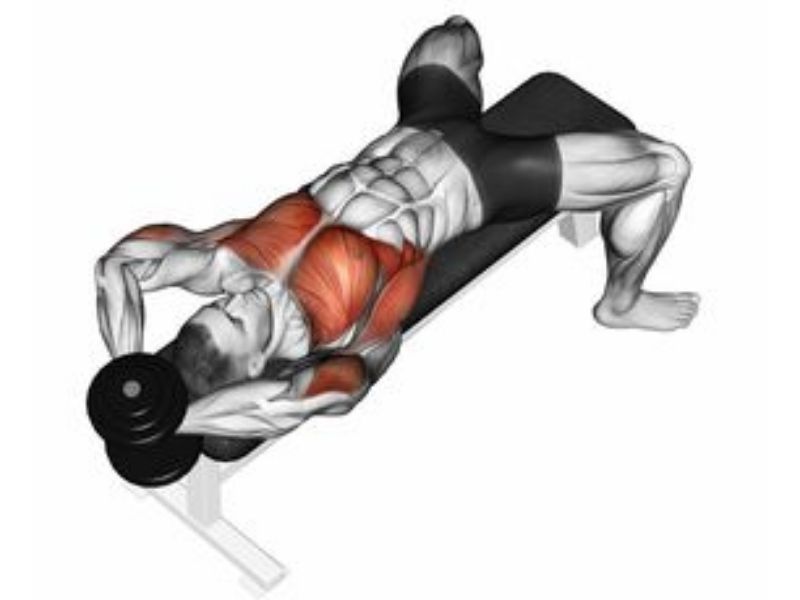
- This exercise can be a bit more challenging for beginners, so listen to your body and skip it if needed.
- Lie on a flat bench with your knees bent and feet flat on the floor.
- Hold a dumbbell with both hands directly above your chest, palms facing each other. Feel a slight stretch in your chest muscles here.
- Slowly lower the dumbbell down in a wide arc behind your head, keeping your arms mostly straight.
- Don’t lower the weight so far that it hurts your shoulders. Stop when you feel a stretch in your chest.
- Squeeze your chest muscles to bring the dumbbell back up to the starting position directly above your chest.
Pro-tip: Imagine your chest is stretching open as you lower.
Seated Row with Chest Supported
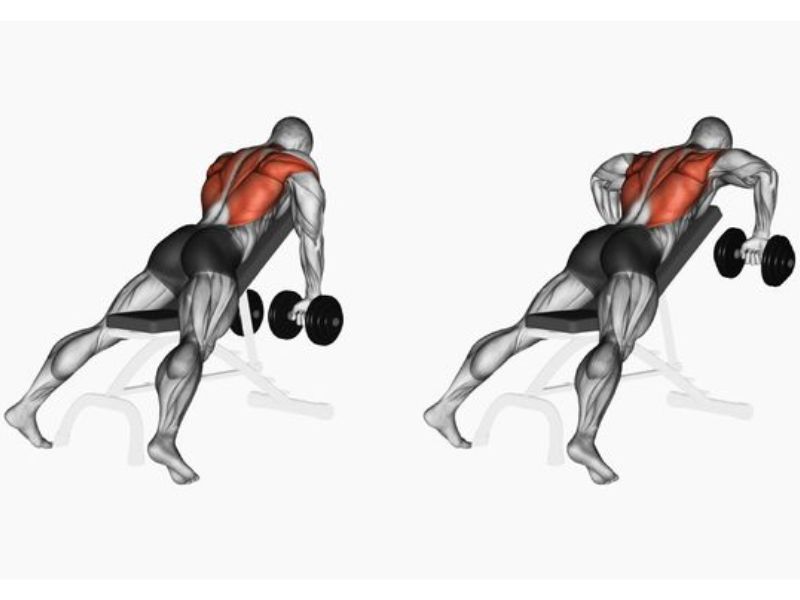
- A great option for beginners as it helps maintain proper back form.
- Sit on a bench with a backrest that allows you to lean back slightly.
- Rest your chest comfortably on the pad and hold a dumbbell in each hand with palms facing each other. Let your arms hang straight down from your shoulders. Feel a slight stretch in your lats (sides of your back) here.
- Row the dumbbells up towards your sides, keeping your elbows close to your body and squeezing your shoulder blades together at the top.
- Lower the dumbbells back down to the starting position with control, maintaining a slight lean back and keeping your core engaged.
Pro-tip: Imagine pinching your shoulder blades in your back pocket. Feel your back muscles doing the work.
Dumbbell one-arm row
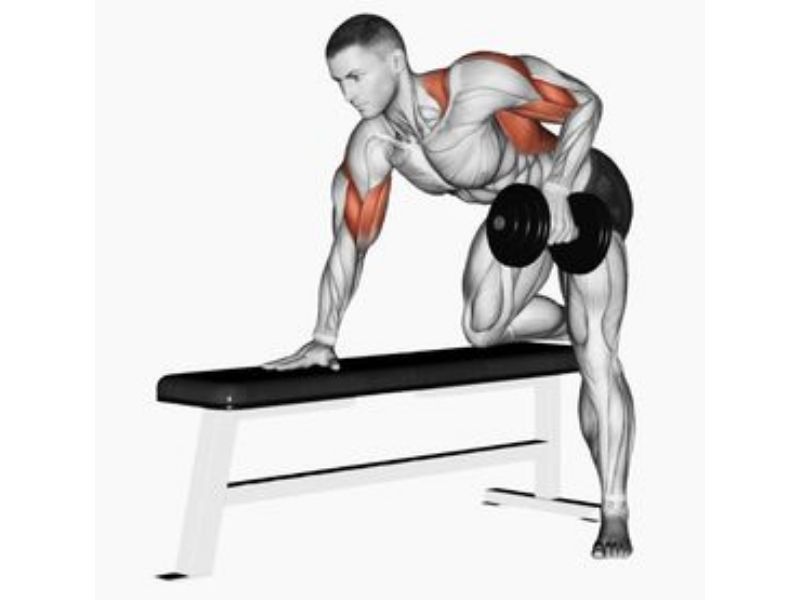
- This exercise challenges your core stability and allows you to focus on each side of your back individually.
- Stand with one foot in front of the other for stability and hinge at your hips, pushing your glutes back and keeping your back straight. Hold a dumbbell in the hand opposite the front leg, arm straight down towards the floor. Feel a slight stretch in your lat (side) of the back here.
- Row the dumbbell up towards your side, keeping your elbow close to your body and squeezing your shoulder blade back at the top.
- Lower the dumbbell back down to the starting position with control, maintaining the hinge at your hips and a straight back. Repeat on the other side.
Pro-tip: Imagine pinching your shoulder blade in your back pocket. Feel your back muscle doing the work, not your bicep.
SHOULDER
Dumbbell Front Raise:
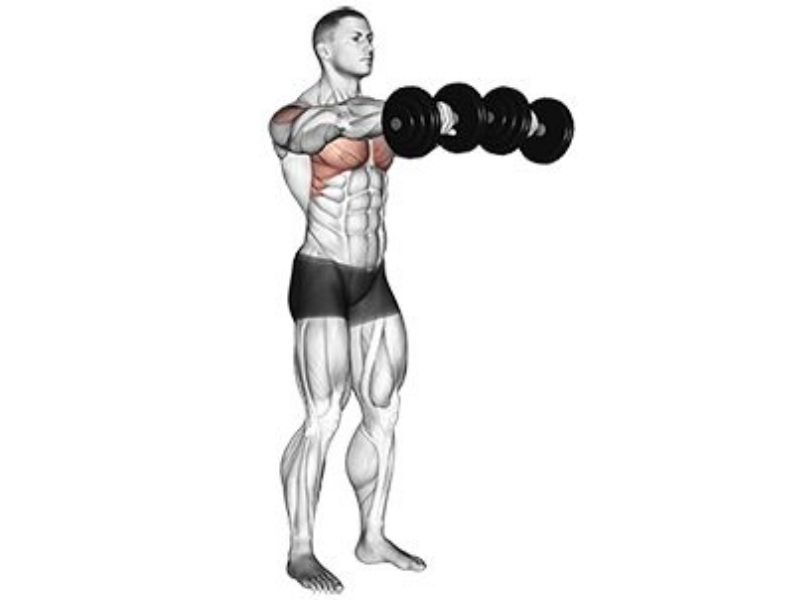
- Grab dumbbells that feel challenging but manageable.
- Stand tall with your feet shoulder-width apart and core engaged (imagine pulling your belly button in towards your spine).
- Hold the dumbbells with palms facing forward, arms straight down by your sides. Feel a slight stretch in the front of your shoulders here.
- Now, raise the dumbbells slowly straight up in front of you, keeping them close to your body.
- Lower the dumbbells back down to the starting position with control, feeling your shoulders working throughout the movement.
Pro-tip: Imagine you're showcasing the muscles on the front of your shoulders. Don't raise them any higher than shoulder level.
Shoulder Press:
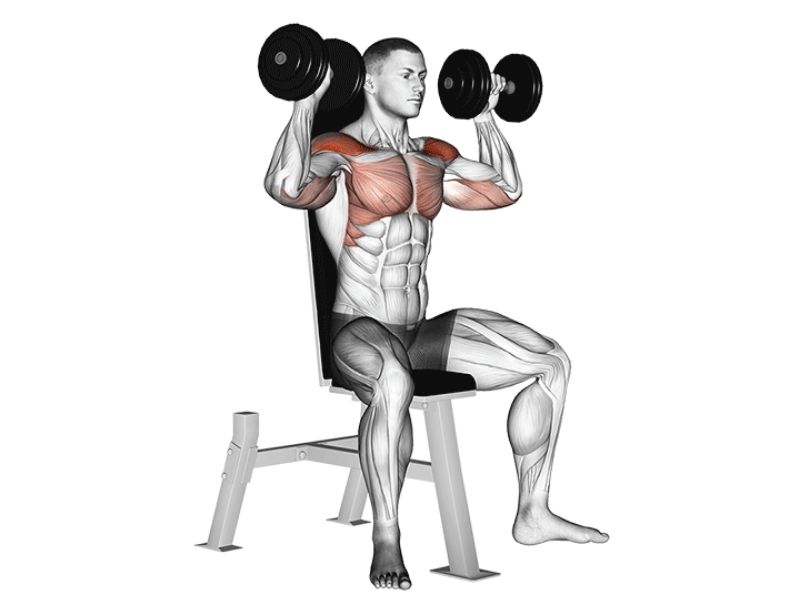
- This exercise works multiple parts of your shoulder.
- Stand tall with your feet shoulder-width apart and core engaged.
- Hold the dumbbells directly above your shoulders, palms facing forward. Feel your shoulders slightly stretched here.
- Lower the dumbbells down in a controlled arc on either side of your head, bending your elbows at a 90-degree angle.
- Press the dumbbells back up to the starting position directly above your shoulders, feeling your shoulders powering the movement.
Pro-tip: Imagine your upper arms are close to your body, forming a box with your elbows and forearms. Feel your shoulders working to lower the weights.
Dumbbell Lateral Raise:
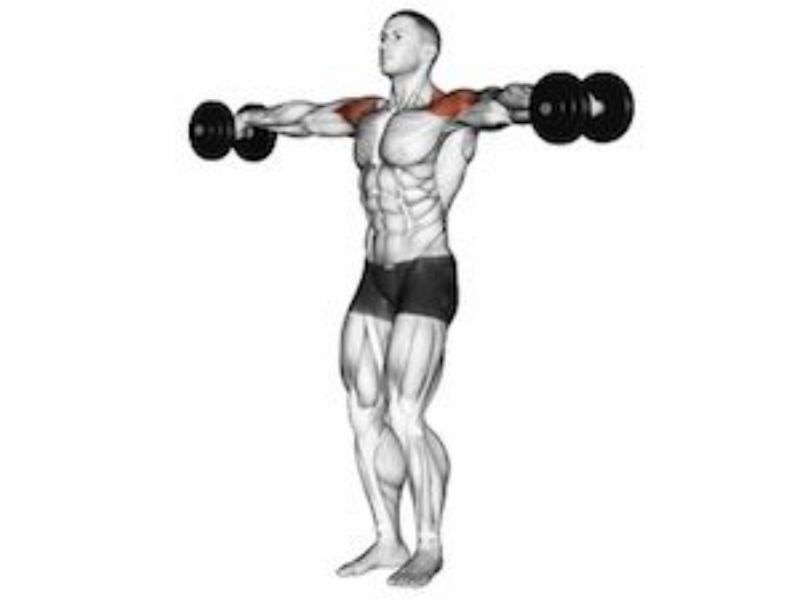
- This exercise targets your outer shoulders.
- Stand tall with your feet shoulder-width apart and core engaged.
- Hold the dumbbells down by your sides, palms facing your body. Feel a slight stretch in your outer shoulders here.
- Raise the dumbbells out to the sides slowly, keeping your arms mostly straight but with a slight bend at the elbow.
- Lower the dumbbells back down to the starting position with control, feeling your outer shoulders working throughout the movement.
Pro-tip: Imagine you're pouring water out of a container held in each hand. Don't raise your arms higher than shoulder level.
Upright Row with dumbbell:
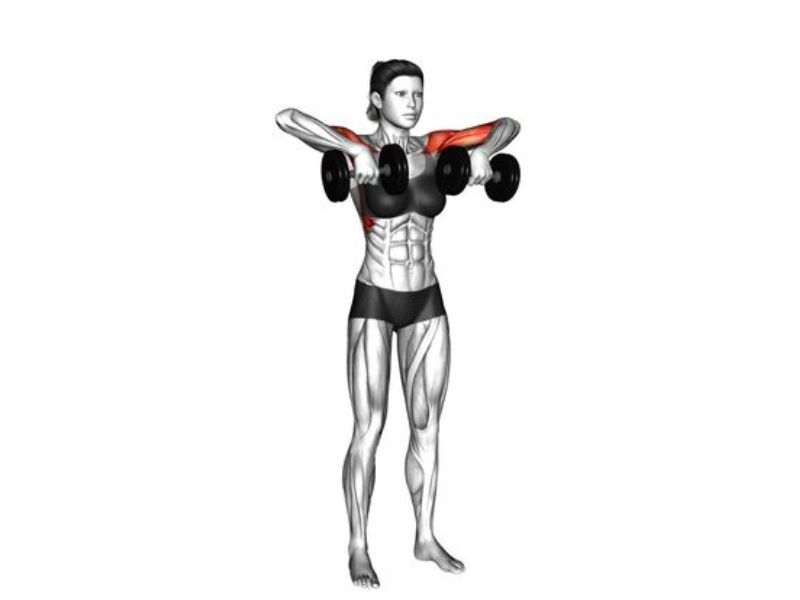
- This exercise can put stress on your shoulders if not done with proper form, so start light and pay attention to any discomfort.
- Stand tall with your feet shoulder-width apart and core engaged.
- Hold the dumbbells down by your sides, palms facing your body. Feel a slight stretch in your shoulders here.
- Raise the dumbbells up towards your shoulders in a controlled arc, keeping your elbows close to your body. Don’t raise them any higher than shoulder level.
- Lower the dumbbells back down to the starting position with control, feeling your shoulders working throughout the movement.
Pro-tip: Imagine you're bringing your elbows towards the ceiling
Dumbbell Reverse Flyes:
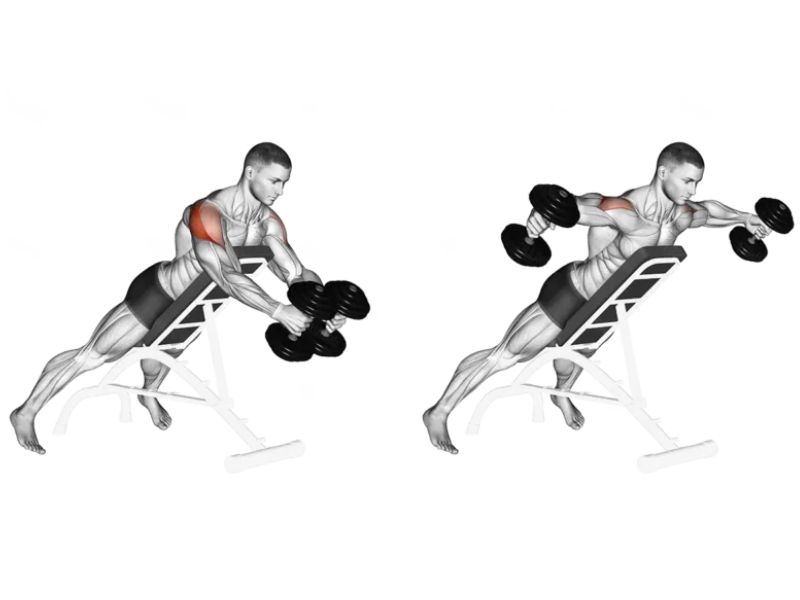
- Find a comfortable incline bench, around 30 degrees.
- Lie face down on the bench with your chest resting on the pad and feet flat for stability.
- Hold a dumbbell in each hand with palms facing each other and arms hanging straight down towards the floor (feel a stretch in your back shoulders).
- Imagine pinching your shoulder blades back as you raise the dumbbells up in a smooth arc, squeezing your back shoulder muscles.
- Lower the dumbbells back down slowly with control.pen_spark
LEGS
Romanian Deadlifts
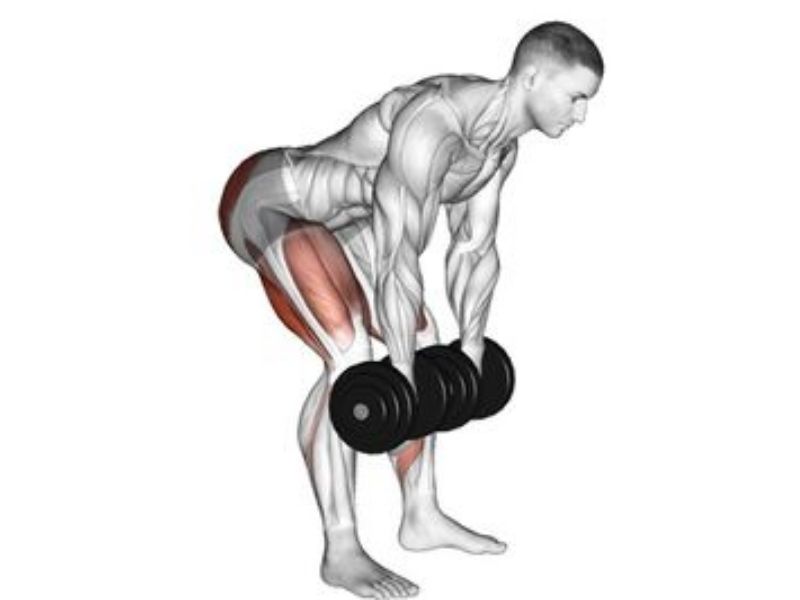
- Same setup as the back Romanian Deadlift, but let’s focus on feeling it in your legs this time.
- Grab dumbbells that challenge you, but allow you to maintain good form throughout.
- Stand with your feet shoulder-width apart and hinge at your hips, pushing your glutes back as if you’re about to sit in a chair. Keep your back straight but not hyperextended (think proud chest).
- Hold the dumbbells with palms facing each other, arms straight down towards the floor. Feel a slight stretch in your hamstrings (back of your thighs) here.
- Lower the dumbbells down along your legs, keeping them close to your body. Focus on feeling your hamstrings lengthen and stretch as you go down.
- Stop lowering the weights once you feel a strong stretch in your hamstrings or your back starts to round.
- Squeeze your glutes and hamstrings to push yourself back up to the starting position, maintaining the hinge at your hips and a straight back.
Dumbbell Hamstring Curls:
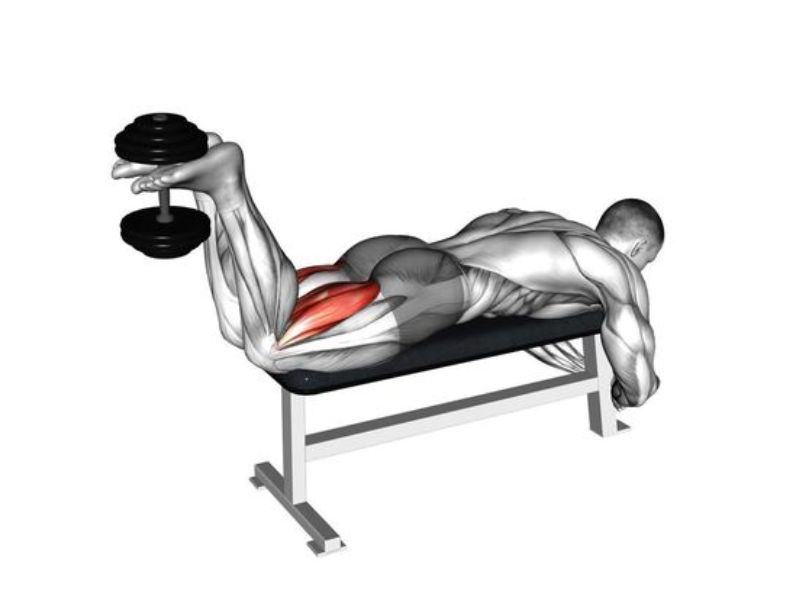
- Lie face down on a flat bench with your heels hooked over the edge of the bench.
- Hold a dumbbell in each hand with palms facing down. Let your arms hang straight down towards the floor. Feel a slight stretch in the back of your thighs here.
- Curl your heels up towards your glutes, squeezing your hamstrings as you lift.
- Slowly lower the dumbbells back down to the starting position with control, feeling the stretch return to your hamstrings.
Pro-tip: Imagine pulling your heels up towards your glutes without using your back.
Bulgarian Split Squats:
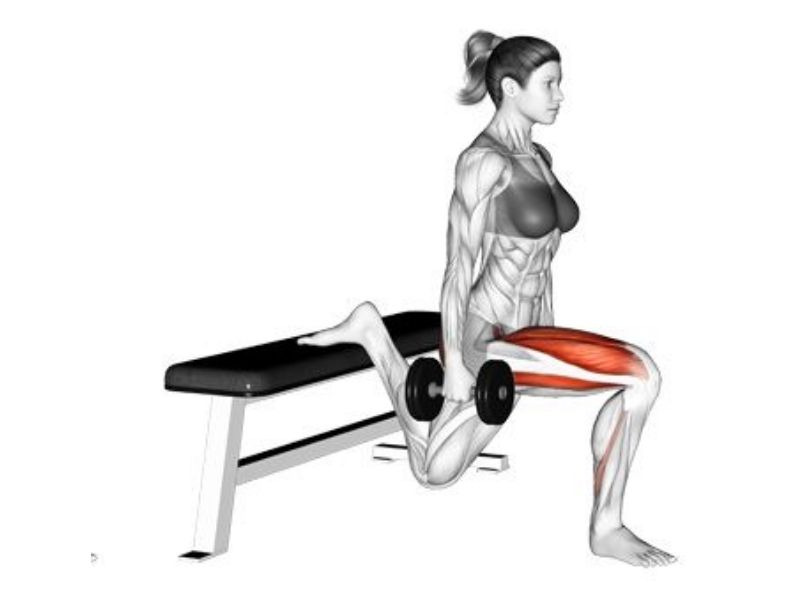
- This exercise challenges your balance and core stability while working your legs.
- Stand with one foot in front of a sturdy bench or chair, the other leg extended behind you. Hold a dumbbell in each hand with palms facing your thighs.
- Lower yourself down as if doing a squat, bending the knee of your front leg and keeping your back straight.
- Descend until your front knee is bent at a 90-degree angle and your back knee nearly touches the ground.
- Press through your front heel to push yourself back up to the starting position, keeping your core engaged and back straight. Repeat on the other side.
Pro-tip: Imagine sinking your hips down and feeling the work in your front thigh.
Squats:
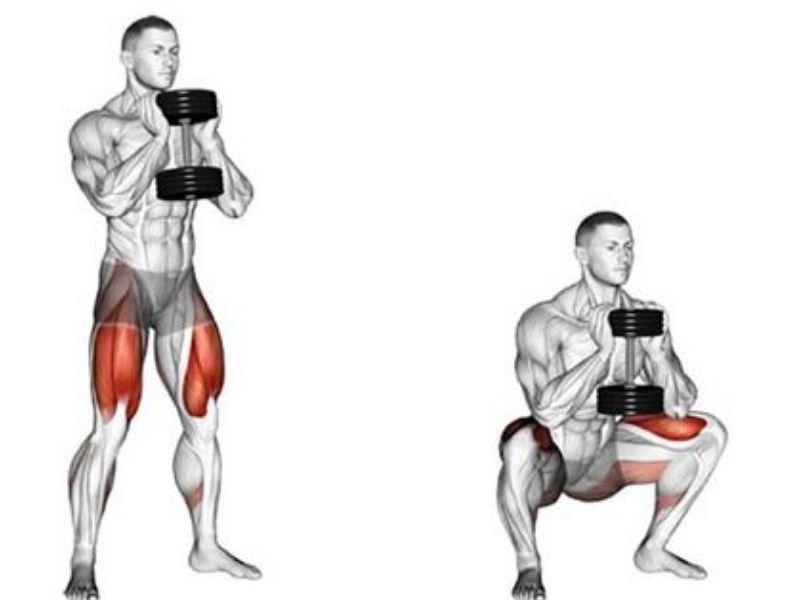
- The king of lower body exercises!
- Stand tall with your feet shoulder-width apart and toes slightly pointed outwards. Hold a dumbbell in each hand with palms facing your body. Keep your core engaged and shoulders back. Feel tall and proud here.
- Lower yourself down as if you’re going to sit in a chair, keeping your back straight and pushing your hips back.
- Squat down until your thighs are parallel to the floor (or as low as comfortably possible), feeling the work in your glutes and quads (front of your thighs).
- Press through your heels to stand back up to the starting position, keeping your core engaged and back straight.
Pro-tip: Imagine your knees tracking over your toes as you squat.
Dumbbell Lunges:
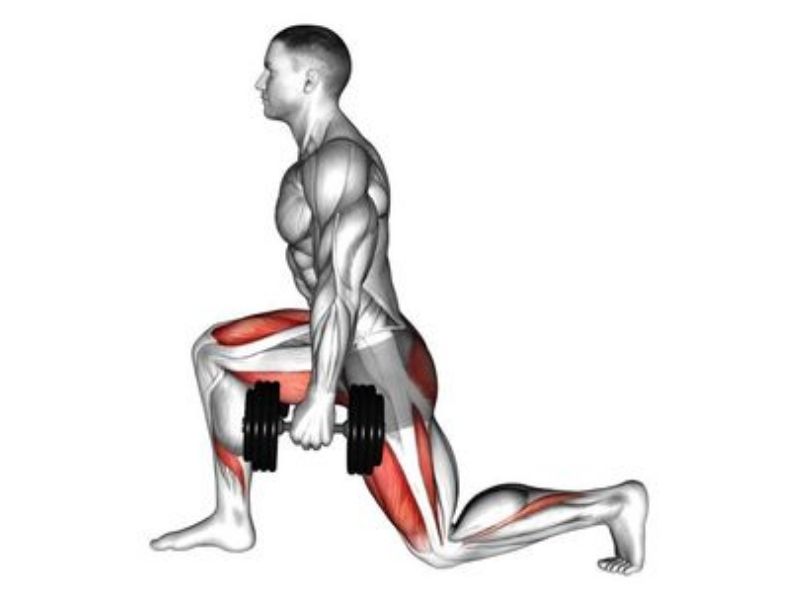
- Lunges are great for working your quads, hamstrings, and glutes.
- Stand tall with your feet hip-width apart and hold a dumbbell in each hand with palms facing your thighs.
- Take a big step forward with one leg, lowering your body down as if doing a lunge. Bend both knees at 90-degree angles, keeping your front knee over your ankle and your back knee pointing towards the floor.
- Lower yourself down until your back knee nearly touches the ground. Feel the work in both your front and back leg.
- Push through your front heel to stand back up to the starting position, bringing your feet back together. Repeat on the other side.
Pro-tip: Imagine your front shin staying vertical.
BICEPS
Dumbbell Hammer Curls

- Grab dumbbells that feel challenging but manageable.
- Stand tall with your feet shoulder-width apart and core engaged.
- Hold the dumbbells with palms facing your body, arms straight down by your sides. Feel a slight stretch in your forearms here.
- Now, curl the dumbbells up towards your shoulders, keeping your elbows tucked in close to your body and your palms facing your body throughout the movement.
- Lower the dumbbells back down to the starting position with control, feeling your biceps working to lower the weight.
Pro-tip: Imagine hammering the dumbbells up towards your shoulders.
Incline Dumbbell Curls
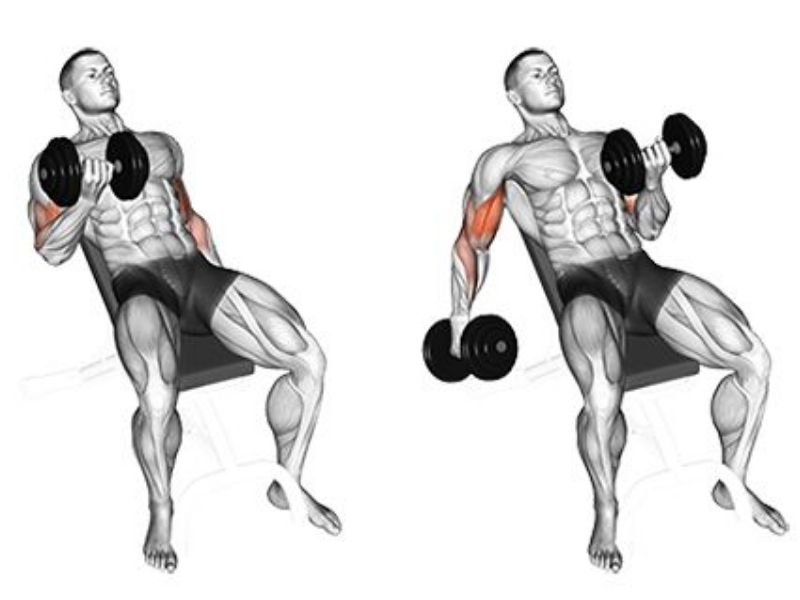
- This exercise can be a bit more challenging than regular curls, so listen to your body and skip it if needed. You can also perform regular standing curls instead.
- Sit on an adjustable bench set at an incline (around 30-45 degrees).
- Hold a dumbbell in each hand with palms facing forward. Let your arms hang down comfortably beside you. Feel a slight stretch in your biceps here.
- Curl the dumbbells up towards your shoulders, keeping your elbows close to your body and squeezing your biceps at the top.
- Lower the dumbbells back down to the starting position with control, feeling the stretch return to your biceps.
Pro-tip: Imagine flexing your biceps to bring the weights up.
Dumbbell Preacher Curls :

- This exercise requires a preacher curl pad at the gym, so you can skip it if you don’t have access to one. You can focus on the other curl variations instead.
- Sit on the preacher curl pad and adjust the pad height so it supports the backs of your upper arms comfortably.
- Hold a dumbbell with your palm facing forward. Let your arm hang down from the pad with a slight bend at the elbow. Feel a stretch in your bicep here.
- Curl the dumbbell up towards your shoulder, focusing on squeezing your bicep and keeping your upper arm pressed against the pad throughout the movement.
- Lower the dumbbell back down to the starting position with control, feeling the stretch return to your bicep.
Pro-tip: Imagine flexing your bicep to bring the weight up.
Concentration Curls:
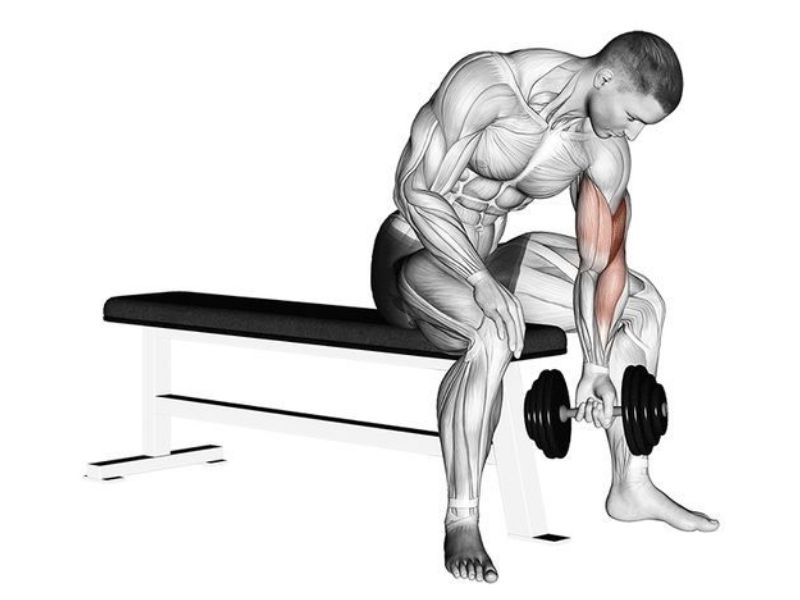
- This exercise helps isolate your bicep muscle and improve bicep mind-muscle connection.
- Sit on a sturdy chair with your legs spread apart for stability.
- Hold a dumbbell in one hand with your palm facing up. Brace your other hand on your inner thigh for support. Let your arm holding the dumbbell hang down relaxed by your side. Feel a slight stretch in your bicep here.
- Curl the dumbbell up towards your shoulder, focusing on squeezing your bicep and keeping your upper arm pressed against your inner thigh throughout the movement.
- Lower the dumbbell back down to the starting position with control, feeling the stretch return to your bicep. Repeat on the other side.
Pro-tip: Imagine flexing your bicep to bring the weight up.
Dumbbell Spider Curls :
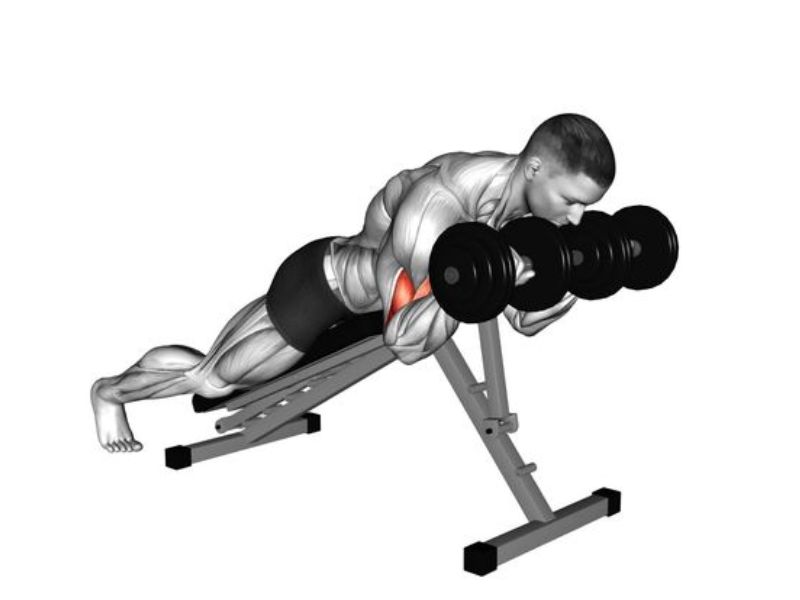
- This exercise can be a bit more advanced for beginners, so listen to your body and skip it if needed. You can focus on the other curl variations instead.
- Get on all fours with your hands shoulder-width apart and knees hip-width apart. Keep your back flat and core engaged.
- Hold a dumbbell in one hand with your palm facing down. Let your arm hang down comfortably below your shoulder. Feel a slight stretch in your bicep here.
- Curl the dumbbell up towards your chest, focusing on squeezing your bicep and keeping your elbow close to your body throughout the movement.
- Lower the dumbbell back down to the starting position with control, feeling the stretch return to your bicep. Repeat on the other side.
Pro-tip: Imagine pulling the weight up towards your chest with your bicep.
TRICEPS
Dumbbell Overhead Tricep Extension:
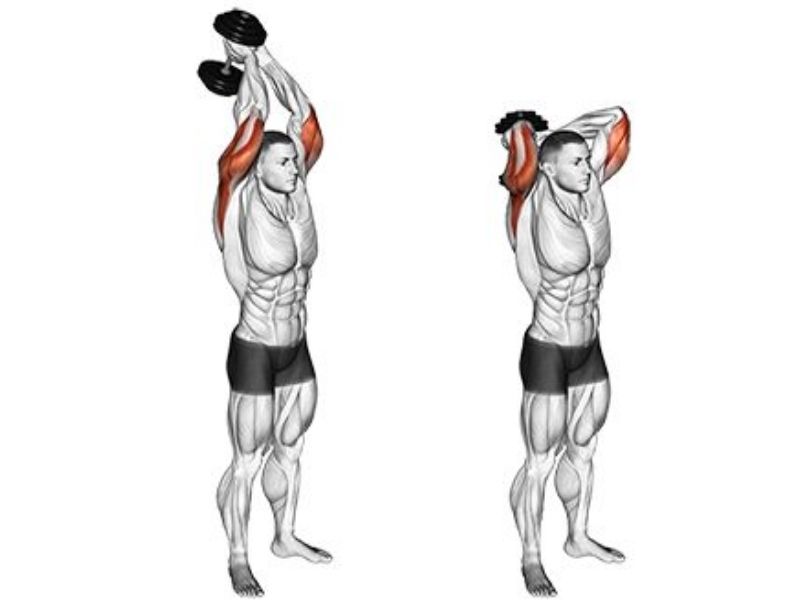
- Grab dumbbells that feel challenging but manageable.
- Stand tall with your feet shoulder-width apart and core engaged.
- Hold the dumbbells directly overhead, palms facing forward. Feel your triceps muscles slightly stretched here.
- Now, lower the dumbbells down behind your head in a slow, controlled arc, keeping your upper arms close to your head. Imagine your elbows are pointing straight back, not flared out to the sides. Feel your triceps working to lower the weights.
- Don’t let the weights touch your head. Stop lowering them when your forearms reach parallel to the floor, or slightly lower if comfortable.
- Press the dumbbells back up to the starting position overhead, feeling your triceps muscles contracting and powering the movement.
Lying Triceps Extension :
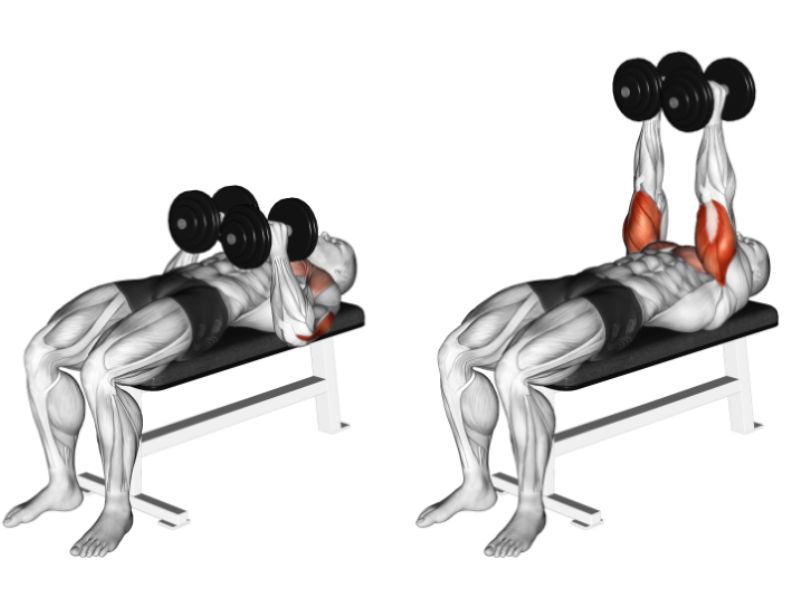
- This exercise can be a bit easier on your back than the overhead extension.
- Lie flat on a flat bench with your knees bent and feet flat on the floor.
- Hold the dumbbells directly above your chest, palms facing forward. Feel your triceps muscles slightly stretched here.
- Lower the dumbbells down in a controlled arc on either side of your chest, bending your elbows at a 90-degree angle. Imagine lowering your forearms towards the floor without flaring your elbows out. Feel your triceps working.
- Don’t let the dumbbells touch your chest. Stop lowering them when your forearms reach near your chest, or slightly lower if comfortable.
- Press the dumbbells back up to the starting position directly above your chest, feeling your triceps muscles contracting and powering the movement.
Dumbbell Close-Grip Bench Press :
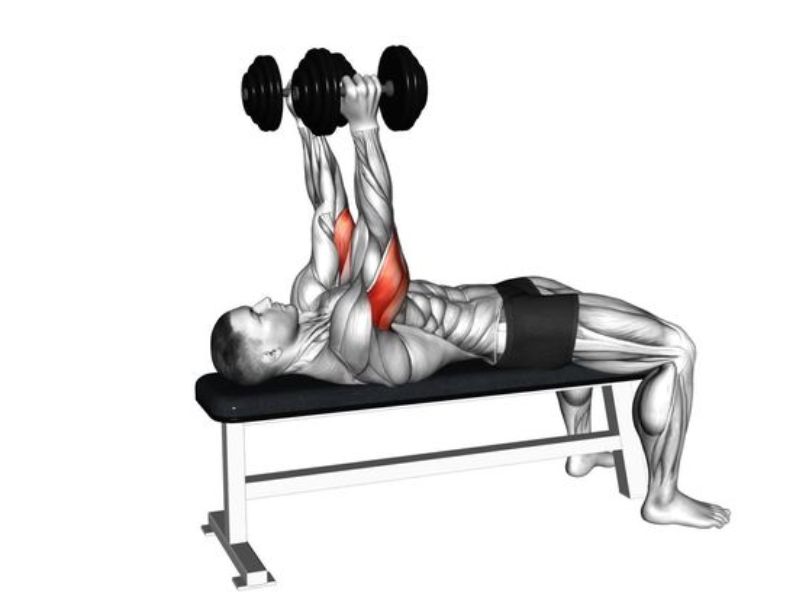
- This exercise can be a bit more challenging than regular dumbbell presses because it targets your triceps more directly. You can skip this one if you prefer and focus on the other exercises.
- Lie flat on a flat bench with your feet flat on the floor.
- Hold dumbbells with palms facing each other, gripped a bit closer together than shoulder-width apart. Feel your triceps muscles slightly stretched here.
- Lower the dumbbells down in a controlled arc towards your chest, keeping your elbows close to your body.
- Don’t let the dumbbells touch your chest. Stop lowering them when your elbows reach a 90-degree angle, or slightly lower if comfortable.
- Press the dumbbells back up to the starting position, feeling your triceps muscles contracting and powering the movement.
Pro-tip: Imagine your elbows tucking in by your sides as you lower. Feel your triceps working to lower the weights.
Dumbbell Triceps Kickbacks:
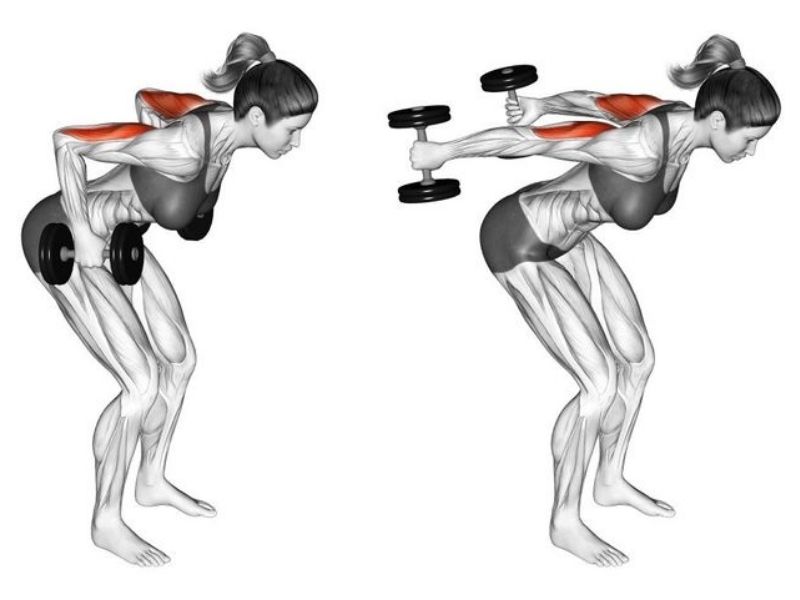
- This exercise isolates your triceps by focusing on the extension movement.
- Stand tall with one knee slightly bent in front of the other for stability and core engaged.
- Hold a dumbbell in one hand with your palm facing inward. Brace your other hand on a sturdy surface for support, or rest it on your thigh. Keep your back straight and core engaged. Feel a slight stretch in the back of your upper arm (tricep) here.
- Keeping your upper arm tucked in close to your body, straighten your elbow to extend the dumbbell back behind you.
- Lower the dumbbell back down to the starting position with control, feeling the stretch return to your triceps. Repeat on the other side.
Pro-tip: Imagine pushing your fist back towards the wall behind you. Feel your tricep working to extend the weight.
What are some common mistakes to avoid when using dumbbells?
As we dive into the world of dumbbell strength training exercises, let’s steer clear of these common blunders to ensure we’re getting the most out of our sweat sessions.
Prioritize Form Over Weight: The Ego-Lifting Trap
Newcomers often fall prey to the “ego lift,” sacrificing proper form for heavier dumbbells. Remember, lifting weights to show off won’t get you anywhere.
Instead, focus on dumbbell strength training that challenges you to complete 12-15 repetitions with impeccable form. This allows you to control the movement, maximize muscle engagement, and prevent injuries.
Think Light Weights, High Reps for Flawless Form
As a beginner, using lighter dumbbells with higher reps is key. This approach allows you to master proper form and gradually increase weight as you get stronger.
With lighter weights, you’ll be in control, ensuring your muscles, not the dumbbells, dictate the movement.
Focus on the Right Muscle, Not Just the Lift
Lifting heavy dumbbells beyond your capacity can lead to your supporting muscles taking over. For example, during bicep curls, you might use your forearms instead of your biceps.
To ensure you’re working the target muscle, pair the right weight with proper form. This is essential for effective dumbbell strength training.
Warm Up for Injury-Free Workouts
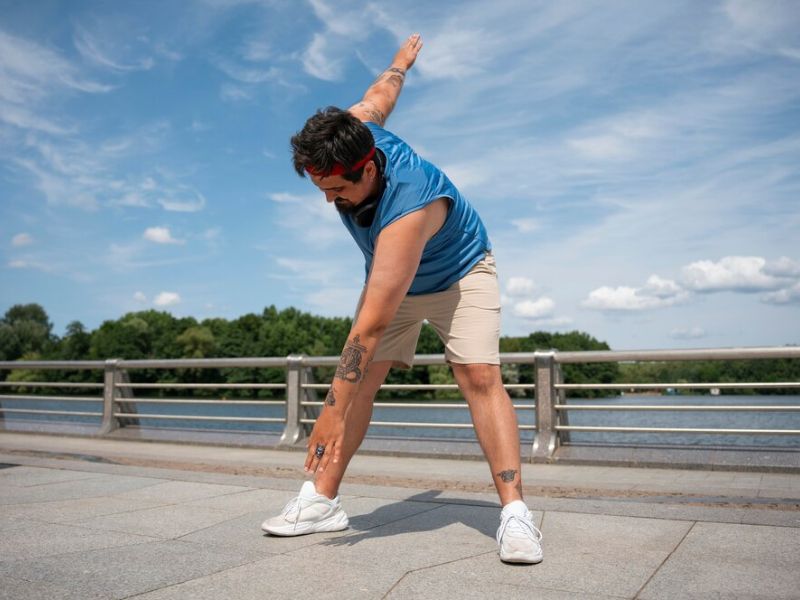
Just like a car engine needs to warm up before hitting the highway, your muscles need the same courtesy. A proper warm-up increases blood flow, preparing your body for exercise and reducing the risk of injury.
Spend a few minutes on dynamic stretches or light cardio to get your body primed.
Cool Down: Don’t Let the Work End with the Last Rep
Cooling down is equally important. After a challenging dumbbell strength training session, your heart rate and blood flow are elevated. A proper cool-down helps bring everything back to resting levels, promotes the removal of waste products from your muscles, and prevents blood pooling. Include static stretches in your cool-down routine to improve flexibility and reduce muscle soreness.
Consistency and Patience: Your Keys to Success
Getting discouraged by a lack of immediate results is common, but remember, building muscle takes time and dedication.
Consistency is your best friend. Stick to your dumbbell strength training routine, push yourself gradually, and celebrate small victories, like lifting heavier weights or adding more reps.
These milestones signify progress, even if the physical changes aren’t yet visible.
Unlocking Versatility: The Power of Dumbbells
Dumbbells are fantastic tools for dumbbell strength training because they allow for a full range of motion in exercises. This unilateral training (working one side of the body at a time) forces your core to stabilize the weight, improving overall form and preventing injuries.
Plus, dumbbells offer incredible exercise versatility, catering to both beginners and advanced lifters. Start with basic exercises like dumbbell squats, rows, and bench presses to build a strong foundation.
As you progress, you can incorporate more complex movements and increase the weight of your dumbbells.
Fuel Your Body for Fitness Success

Don’t underestimate the power of proper hydration and nutrition. Your body needs fuel to perform workouts and recover effectively.
Drink plenty of water throughout the day, especially before, during, and after your dumbbell strength training sessions.
Maintain a balanced diet with sufficient protein, carbohydrates, and healthy fats to support muscle growth and repair.
Rest and Recover: Give Your Muscles Time to Shine

Finally, prioritize rest days! Your muscles need time to recover from challenging workouts and rebuild stronger. Make sure you get enough sleep and schedule rest days into your dumbbell strength training routine. Overtraining can lead to injuries and hinder your progress, so listen to your body and give it the rest it deserves.
Conclusion
In conclusion, incorporating dumbbell strength training exercises into your workout routine is a fantastic way to kickstart your weight loss journey.
By engaging in these exercises, you not only burn calories during your workout but also continue to torch calories even after you’ve finished, thanks to the metabolic boost from increased muscle mass.
However, it’s crucial to avoid common mistakes like improper form and neglecting warm-up and cool-down sessions.


1 thought on “30 Dumbbell Strength Training Exercises For Beginners ”